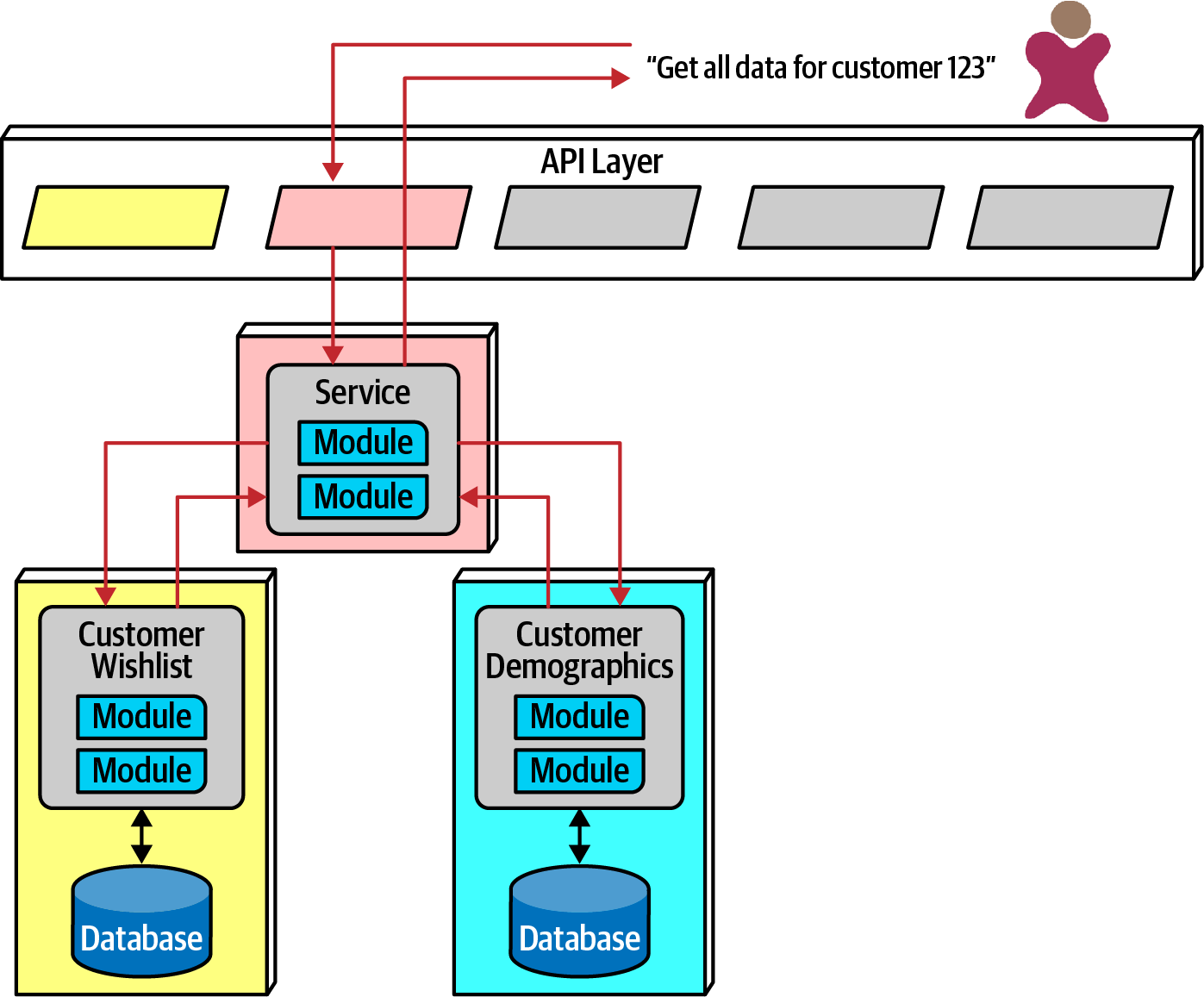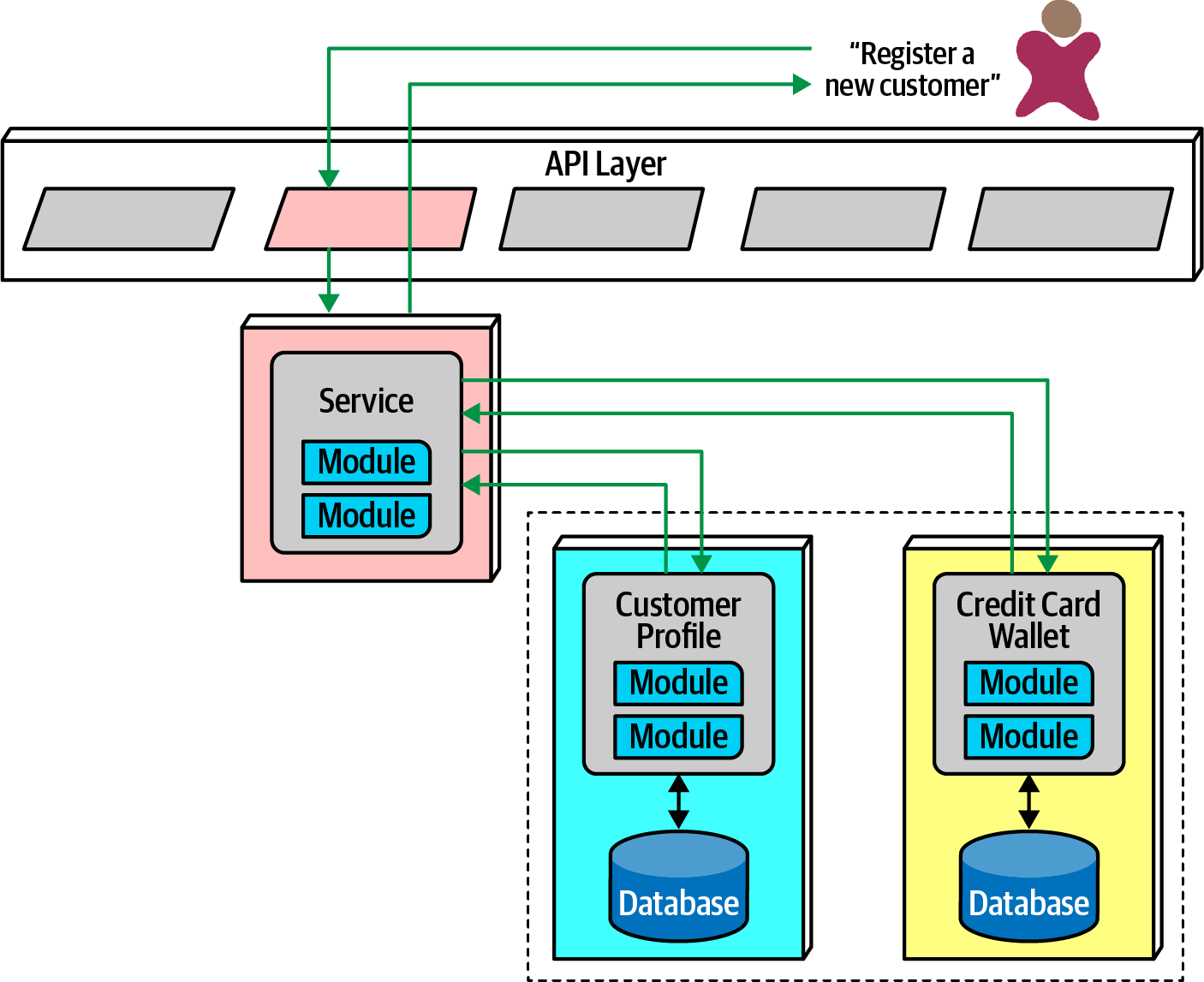Microservices Architecture Style
History
Microservices differs in this regard—it was namewd fairly early in its usage and popularized by a famous blog entry by Martin Fowler and James Lewis entitled Microservices, published in March 2014. They recognized many common characteristics in this relatively new architectural style and delineated them.
A significant influence on microservices comes from domain-driven design (DDD), a logical design process for software projects. One key concept from DDD, known as bounded context, played a decisive role in inspiring microservices.
Reuse, Trade-Offs and First Law of Software Architecture
While reuse holds clear advantages, it's crucial to remember the First Law of Software Architecture, which emphasizes trade-offs. The negative trade-off of reuse is increased coupling. When architects design a system to prioritize reuse, they inherently introduce coupling, whether through inheritance or composition.
In scenarios where the architect's goal emphasizes high degrees of decoupling, microservices favor duplication over reuse. The central objective of microservices is to achieve a high level of decoupling, aligning with the logical notion of bounded context from domain-driven design.
Topology
In the realm of microservices, the architectural topology is characterized by the small size and single-purpose nature of each service. Unlike other distributed architectures, microservices envision services as standalone entities, each encapsulating all the essential components needed for independent operation, including databases and other dependencies.
Example
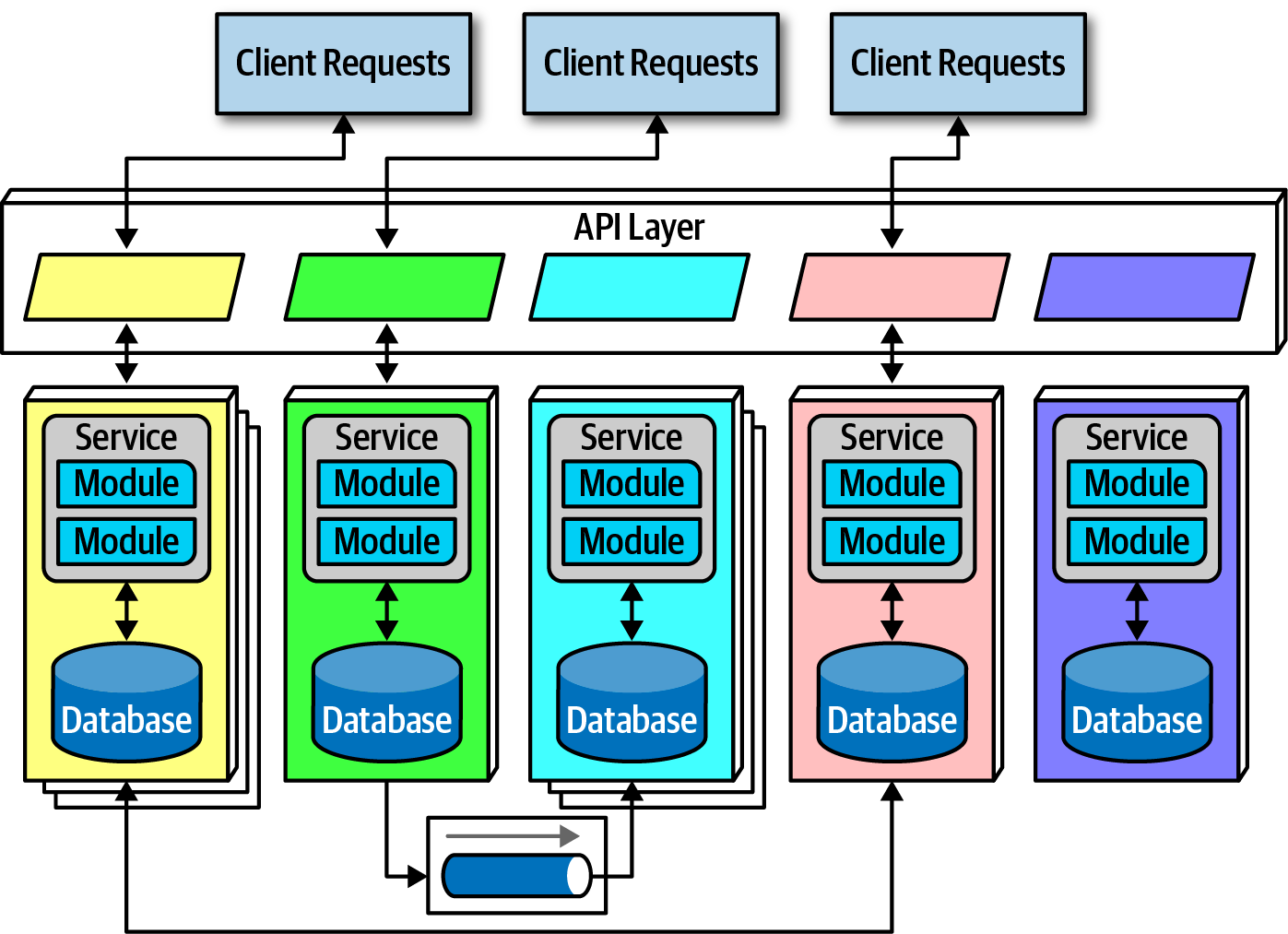
The topology of the microservices architecture style from Fundamentals of Software Architecture.
Distributed
Microservices constitute a distributed architecture, where each service operates in its independent process. Initially tied to physical machines, this concept has evolved to embrace virtual machines and containers. The extensive decoupling of services in a distributed environment addresses common challenges in architectures featuring multitenant infrastructure, offering operational advantages such as efficient resource utilization and improved isolation.
While this distributed approach brings benefits, it also introduces performance considerations. Network calls inherently take longer than local method calls, and security verification at each endpoint adds processing time. Consequently, architects must carefully consider granularity when designing a system to mitigate these implications.
One notable aspect of microservices is the reluctance to employ transactions across service boundaries. Seasoned architects emphasize the importance of determining the appropriate granularity for services as a key factor in achieving success within this architecture.
Bounded Context
The bounded context concept embodies a decoupling strategy. In the context of software development, when a developer defines a domain, that domain includes many entities and behaviors reflected in artifacts such as code and database schemas.
Example
An application might have a domain named CatalogCheckout, encompassing elements like catalog items, customers, and payment.
In a traditional monolithic architecture, developers commonly share these concepts, creating reusable classes and interconnected databases. In a bounded context, however, internal components, like code and data schemas, are tightly coupled to accomplish their work but remain decoupled from anything outside the bounded context, such as a database or class definition from another bounded context. This allows each context to define only what it requires without being influenced by other constituents.
Microservices architecture revolves around the core concept of bounded context, where each service encapsulates a specific domain or workflow. This approach aims to include everything essential for a service to operate independently within the application, discouraging unnecessary coupling and emphasizing duplication over shared resources.
Granularity
Determining the appropriate granularity for services in microservices poses a common challenge for architects. Oversimplifying by creating overly small services can lead to increased communication links between services, impacting overall system efficiency. Striking the right balance is crucial for achieving effective communication and collaboration among services.
Applications may have naturally expansive boundaries for certain segments, acknowledging that certain business processes exhibit higher levels of coupling than others is essential. Architects can navigate this challenge by adhering to guidelines that assist in identifying the most suitable boundaries for effective microservices implementation :
Purpose
Microservices should ideally exhibit high functional cohesion, representing a distinct and significant behavior contributing to the overall application.
Transactions
Minimizing reliance on transactions enhances the robustness of distributed architectures.Bounded contexts are business workflows, and often entities cooperating in transactions can guide architects in defining suitable service boundaries.
Choreography
Architectures that balance domain isolation with communication requirements might benefit from bundling services back into larger entities to mitigate communication overhead, in cases when multiple services require extensive communications.
Iterative refinement is essential for achieving optimal service design. Architects rarely achieve the perfect granularity, data dependencies, and communication styles on the initial attempt. Continuous iteration and refinement increase the likelihood of developing a well-tailored and efficient microservices architecture.
Data Isolation
Microservices necessitates a focus on data isolation, an aspect that distinguishes it from other architecture styles that rely on a single database for persistence. In the pursuit of minimal coupling, microservices avoids shared schemas and databases functioning as integration points.
When determining service granularity, architects must be cautious of falling into the entity trap and resist the temptation to simply model their services to resemble single entities in a database.
Unlike conventional practices of utilizing relational databases for consolidating values within a system to establish a single source of truth, microservices, with its distributed nature, poses a challenge in maintaining this approach. Architects are tasked with deciding how to address this issue: designating one domain as the source of truth for specific information and coordinating with it for value retrieval, or employing database replication or caching for information distribution.
While this level of data isolation may present challenges, it also opens avenues for flexibility. With teams no longer compelled to converge on a single database, each service can opt for the most suitable tool based on factors such as cost, storage type, and other considerations. In a highly decoupled system, teams enjoy the advantage of adapting their choices without affecting other teams, as coupling to implementation details is prohibited.
API Layer
In the microservices paradigm, diagrams often feature an API layer positioned between the system's consumers (user interfaces or calls from other systems), although its inclusion is optional. While the API layer serves various purposes, it should not function as a mediator or orchestration tool if architects intend to adhere to the fundamental philosophy of this architecture. According to this philosophy, all significant logic within microservices should take place within a bounded context, and introducing orchestration or similar logic in a mediator would violate this principle.
This also illustrates the difference between technical and domain partitioning in architecture: architects typically use mediators in technically partitioned architectures, whereas microservices is firmly domain partitioned.
Operational Reuse
In the microservices paradigm, where duplication is favored over coupling, architects face the challenge of handling operational concerns that traditionally benefit from coupling, such as monitoring, logging, and circuit breakers. Unlike the traditional service-oriented architecture philosophy, which promotes reusing both domain and operational functionality, microservices endeavors to separate these two concerns.
As teams build multiple microservices, they recognize common elements that could benefit from a shared approach. The sidecar pattern emerges as a solution to this challenge. Operational concerns are encapsulated within each service as a distinct component, owned either by individual teams or a centralized infrastructure team. This sidecar component efficiently manages all operational aspects that teams find advantageous to couple together. Consequently, when updates or upgrades are needed, the shared infrastructure team can seamlessly update the sidecar, ensuring that each microservice receives the new functionality.
The sidecar pattern not only addresses the challenge of common operational concerns but also facilitates the creation of a service mesh. This mesh allows for centralized control across the architecture for vital concerns like logging and monitoring. The individual sidecar components connect to form a cohesive operational interface, creating a unified experience across all microservices. Each microservice functions as a node within this mesh, offering a console for global control over operational coupling, including monitoring levels, logging, and other cross-cutting operational considerations.
Service discovery plays a crucial role in achieving elasticity in microservices architectures. Instead of directly invoking a single service, requests are routed through a service discovery tool, which monitors request patterns and can scale or spin up new service instances as needed. Architects often integrate service discovery into the service mesh, making it an integral part of every microservice. The API layer is frequently utilized to host service discovery, providing a centralized location for user interfaces or other calling systems to discover and create services in a flexible and consistent manner.
Frontends
Microservices prioritize decoupling, aiming to extend this separation to both backend and user interface concerns. While the original vision of microservices included the user interface as part of the bounded context in alignment with Domain-Driven Design (DDD) principles, practical considerations, particularly in web applications, have presented challenges to fully realizing this goal. As a result, two predominant styles of user interfaces have emerged in microservices architectures.
The first style involves a monolithic frontend, where a single user interface interacts with the backend through the API layer to fulfill user requests. This frontend can take various forms, such as a rich desktop application, mobile app, or web application. For instance, many modern web applications utilize JavaScript web frameworks to construct a unified user interface.
The second option for user interfaces adopts microfrontends, leveraging components at the user interface level to achieve a level of granularity and isolation in sync with the backend services. In this approach, each service emits its own user interface, and the frontend coordinates with these emitted user interface components. This pattern allows teams to establish clear service boundaries from the user interface to the backend services, promoting unity within a single team across the entire domain.
Communication
In microservices, the challenge of determining appropriate granularity impacts both data isolation and communication, influencing how services remain decoupled while still coordinating effectively.
At its core, architects must make a fundamental decision regarding synchronous or asynchronous communication. Synchronous communication entails the caller waiting for a response from the callee. Microservices architectures typically employ protocol-aware heterogeneous interoperability.
Protocol-Aware, Heterogeneous and Interoperability
Protocol-aware
Because microservices lack a centralized integration hub to avoid operational coupling, each service should understand how to call other services. As a result, architects often standardize on specific protocols for inter-service communication, such as a level of REST, message queues, and so forth. This implies that services must be aware of (or discover) the protocol to use when calling other services.
Heterogeneous
Each service may be developed in a different technology stack. Embracing heterogeneity signifies that microservices fully supports polyglot environments, where various services utilize different platforms.
Interoperability
Describing services calling one another, interoperability in microservices aims to discourage transactional method calls while promoting network-based communication.
For asynchronous communication, architects often leverage events and messages, resulting in an internal event-driven architecture. In microservices, the broker and mediator patterns manifest as choreography and orchestration.
Choreography and Orchestration
Choreography in microservices utilizes the communication style of a broker event-driven architecture. Unlike architectures with a central coordinator, choreography adheres to the bounded context philosophy, promoting the implementation of decoupled events between services. In this approach, each service independently calls others as needed, without relying on a central mediator.
Choreography
Suppose a user requests details about a wish list, and the CustomerWishList service lacks essential information. In choreography, it would make a direct call to CustomerDemographics to retrieve the missing data, delivering the result back to the user.
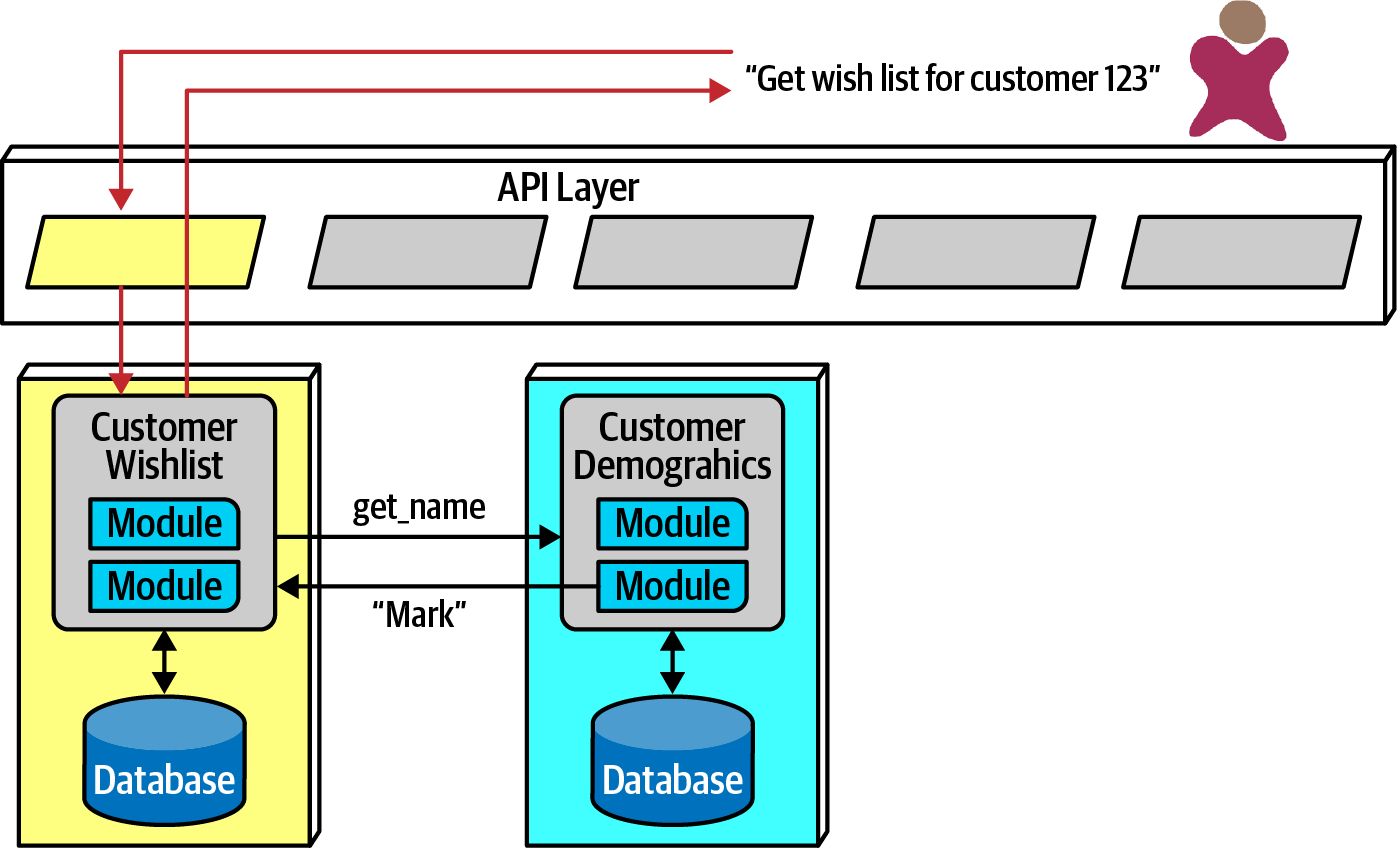
Using choreography in microservices to manage coordination from Fundamentals of Software Architecture.
Because microservices architectures lacks a global mediator like in some service-oriented architectures, allow architects to create localized mediators when coordination across multiple services is necessary. Developers can design a service dedicated to coordinating specific calls, such as obtaining comprehensive customer information. Users then interact with this mediator service, which, in turn, communicates with the required services.
The First Law of Software Architecture acknowledges that neither choreography nor orchestration is flawless—each comes with trade-offs. In choreography, architects uphold the highly decoupled philosophy of the architecture, maximizing the benefits it offers. However, handling common challenges like error management and coordination becomes more intricate in choreographed environments.
In scenarios involving complex workflows, the initial service called may need to act as a mediator, coordinating interactions across a range of other services. This pattern, known as the front controller pattern, transforms a nominally choreographed service into a more complex mediator. The drawback lies in the increased complexity within the service.
Complex Choreography
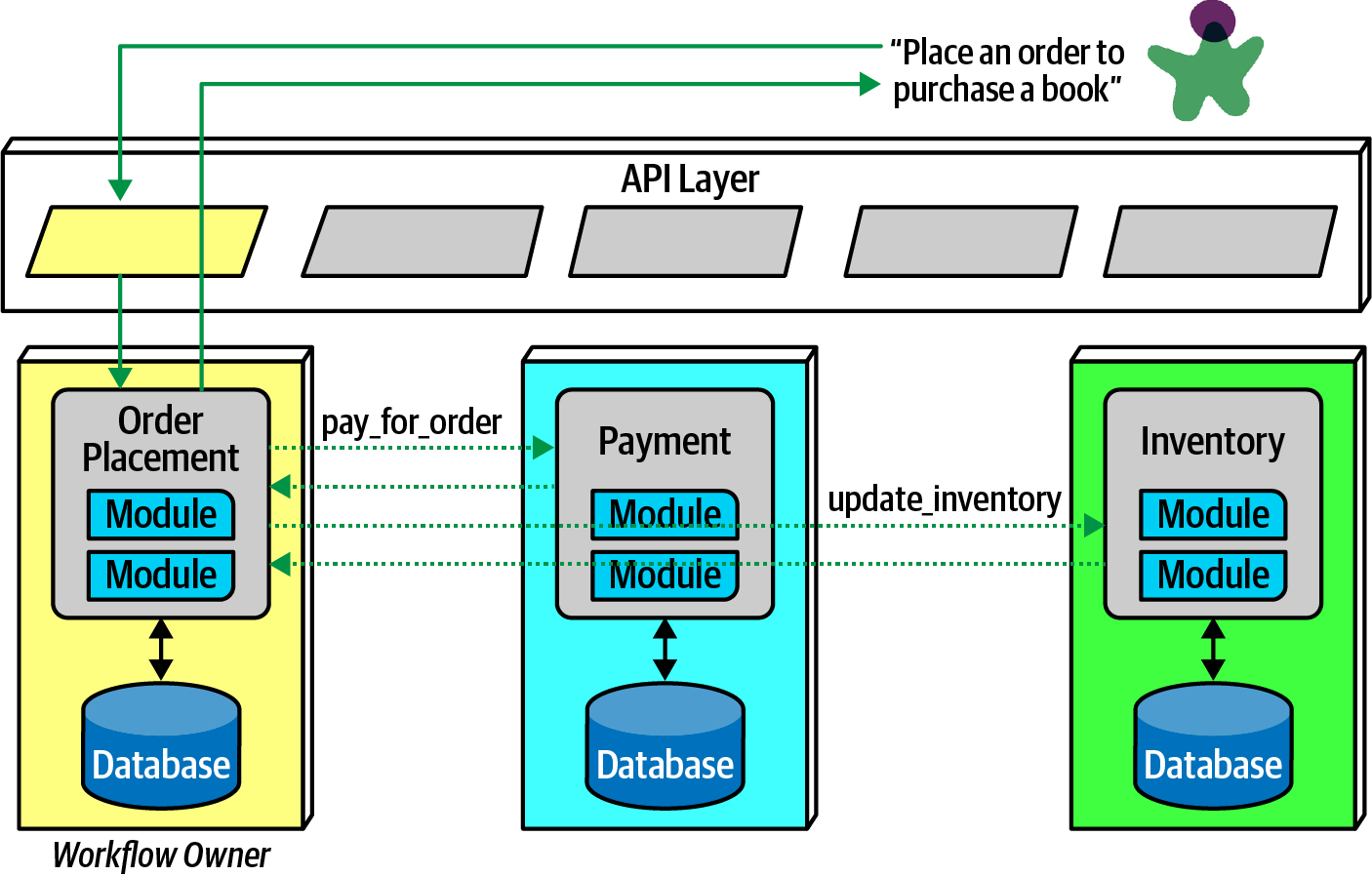
Using choreography for a complex business process from Fundamentals of Software Architecture.
On the other hand, architects may opt for orchestration in handling intricate business processes. By constructing a mediator, architects manage the complexity and coordination required for the business workflow. While this introduces coupling between services, it enables architects to concentrate coordination efforts into a single service, minimizing the impact on others. Often, domain workflows inherently involve some level of coupling, challenging architects to represent that coupling in ways that align with both domain and architectural objectives.
Complex Orchestration
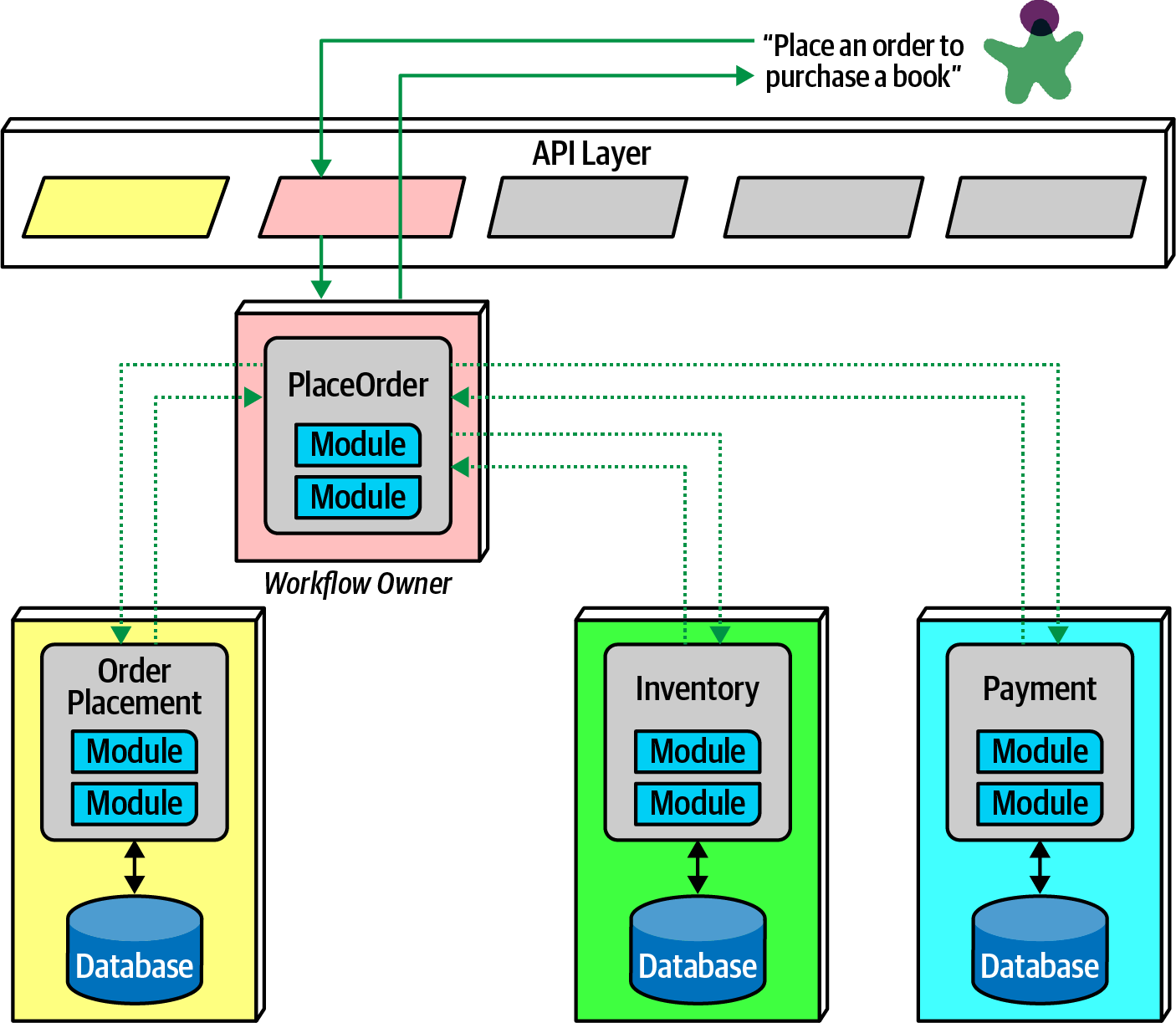
Using orchestration in microservices from Fundamentals of Software Architecture.
Transactions and SAGAS
Architects in the realm of microservices looks for extreme decoupling, but they often grapple with the challenge of coordinating transactions across services. The same level of decoupling that characterizes the architecture, especially in terms of databases, complicates achieving the atomicity that was once straightforward in monolithic applications.
Constructing transactions that span service boundaries contradicts the fundamental decoupling principle of microservices and introduces a form of dynamic connascence, the worst known connascence, the connascence of value. The foremost advice for architects contemplating transactions across services is unequivocal: avoid it! Instead, address the granularity of components. Transaction boundaries often serve as a key indicator of service granularity.
Danger
The foremost advice for architects contemplating transactions across services is unequivocal: avoid it! Instead, address the granularity of components. Transaction boundaries often serve as a key indicator of service granularity.
Tip
Don’t do transactions in microservices. Fix granularity instead!
For services that still demanding transactional coordination, there are patterns available to manage transaction orchestration, with significant trade-offs.
One prevalent distributed transactional pattern in microservices is the saga pattern. In this approach, a service assumes the role of a mediator, orchestrating multiple service calls and coordinating the transaction. The mediator initiates each part of the transaction, logs success or failure, and manages the overall outcome. If everything proceeds as planned, all values in the services and their associated databases update synchronously.
In the event of an error, the mediator ensures that no part of the transaction succeeds if another part fails. If the initial part succeeds but the subsequent part encounters a failure, the mediator sends a request to all successful parts, instructing them to undo their previous actions. This style of transactional coordination is known as a compensating transaction framework. Typically, developers implement this pattern by placing each mediator-initiated request in a pending state until the overall success is signaled by the mediator. However, this design complexity intensifies when dealing with asynchronous requests, especially if new requests depend on pending transactional states. It also results in increased coordination traffic at the network level.
Example
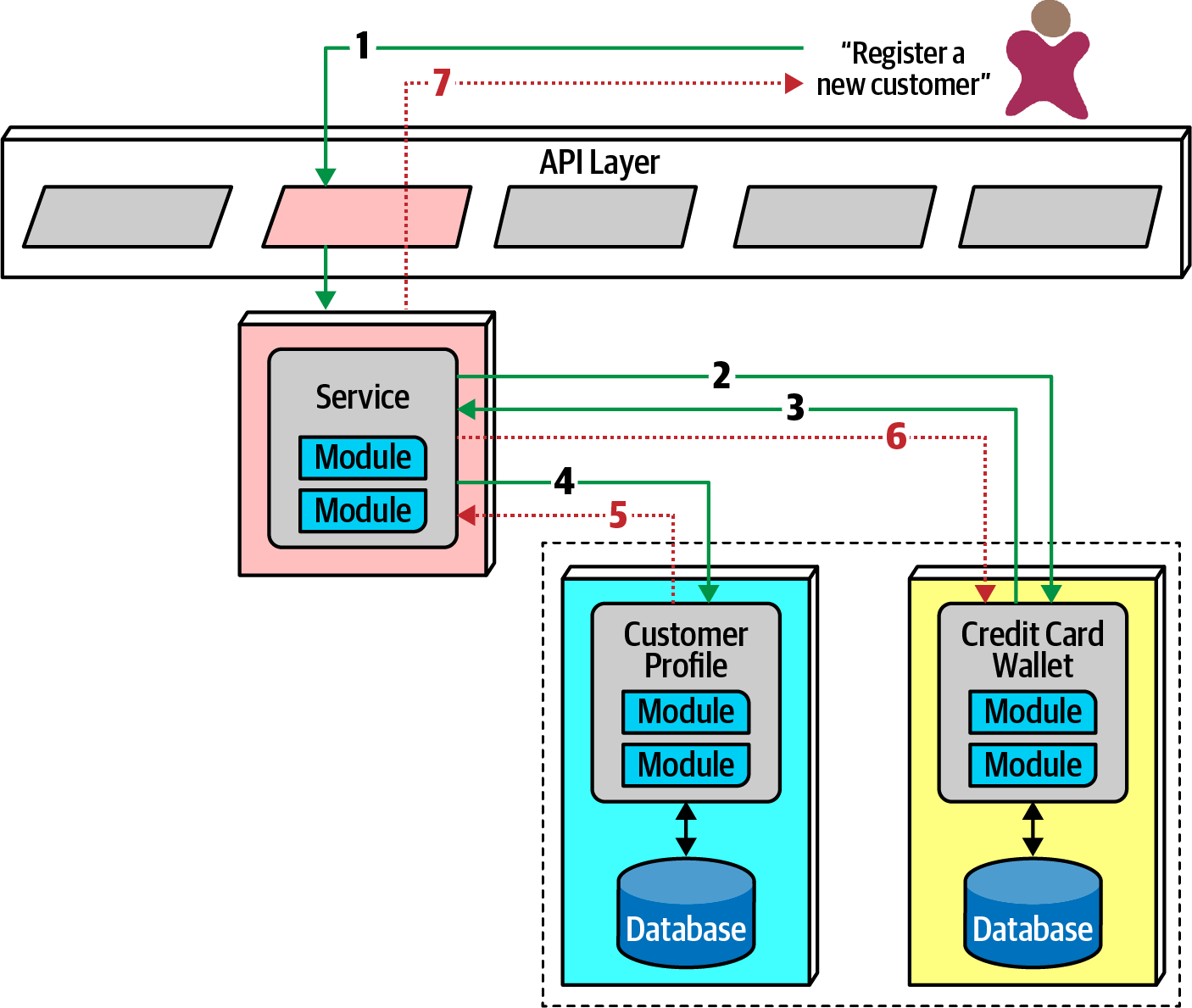
Saga pattern compensating transactions for error conditions from Fundamentals of Software Architecture.
An alternative implementation of a compensating transaction framework involves developers creating both do and undo operations for each potentially transactional operation. While this approach reduces coordination during transactions, the undo operations tend to be considerably more complex than their counterpart do operations, essentially doubling the effort required for design, implementation, and debugging.
While architects can technically build transactional behavior across services, doing so contradicts the core rationale behind choosing the microservices pattern. While exceptions may arise, the overarching advice for architects is to use the saga pattern judiciously.
Tip
A few transactions across services may be necessary, but if they dominate the architecture, it indicates potential mistakes in the design!
